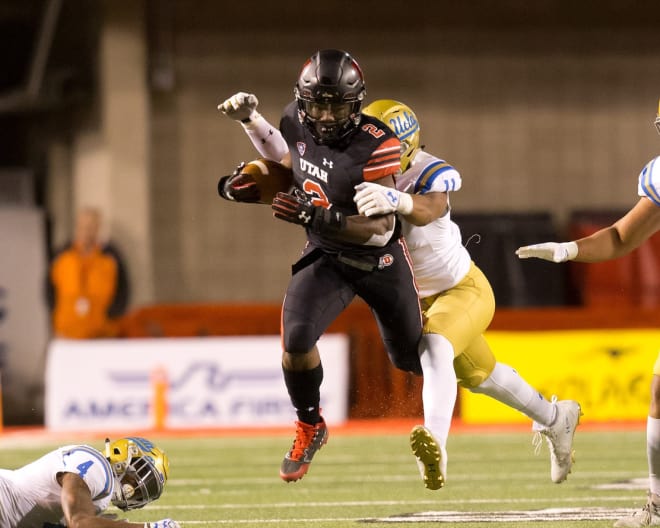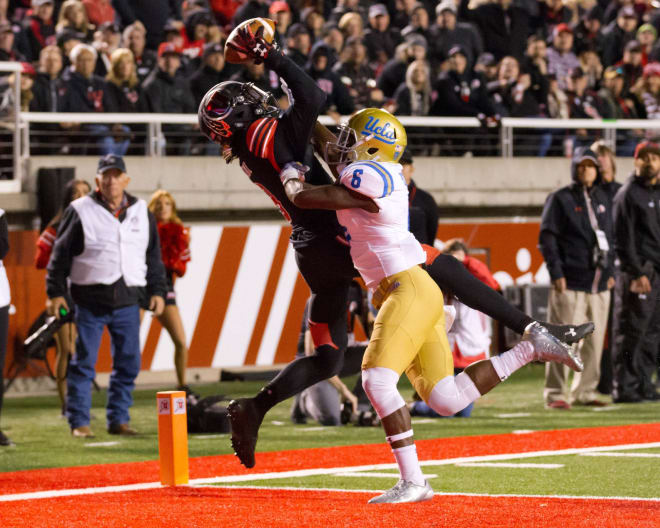Countdown 34 Days: Looking Back at the UCLA Game
The University of Utah enters 2018 as a strong contender to win the Pac-12 South, due to the fact that they return so much experience. Therefore, leading into fall camp, we’ll be taking a game-by-game look back at Utah’s 2017 season to see what went right, what went wrong, and what the Utes can build off of going into the 2018 season.
Game 9—Utah 48, UCLA 17
Utah’s season up to this point had been a tale of two months. The Utes started their season hot, going 4-0 out of the gate and picking up a tough win on the road against Arizona, despite seemingly having players drop like flies against the Wildcats. Throughout the month of October, however, those injuries took their toll, and the Utes dropped four straight games, including two blowout losses to ASU and Oregon. Sitting at 4-4, Utah returned home to take on a UCLA squad that was in a similar situation, and that was missing their star QB, Josh Rosen.
After the previous month’s struggles, bowl eligibility was in question, but the Utes were determined to show that they weren’t done yet, and they came out and played their most complete game of the season, utterly demolishing the Bruins.
Offensive Keys to the Win—Balance, Paul Toala, and No Turnovers
Tyler Huntley returned to his dynamic self as he found his groove in this game. He looked completely back to his pre-injury form, and finished the game with a very efficient 15-22 passing, for 234 yards and four touchdowns. Huntley spread the ball around to eight different targets, with three different guys accounting for 50 yards or more worth of receptions, and three different receivers hauling in touchdown passes. Utah’s passing scheme looked much more diverse and creative than it had in many previous games, where they had relied heavily on short, easy passes to help Troy Williams and a banged up Huntley to move the ball through the air. The play of the game through the air came on the very first snap of the second half, when Troy McCormick ran a wheel route and UCLA blew the coverage, allowing Huntley to play easy pitch and catch with McCormick, who took the reception 75 yards for a touchdown.
The other part of the equation came on the ground, where the Utes totaled 272 yards on 50 attempts, for a per-carry average of 5.4 yards. Both Zack Moss and Huntley were on fire against the Bruins, as Moss tallied 153 yards and two touchdowns on 23 carries, while Huntley added another 93 yards on 18 attempts. Part of this had to do with UCLA’s miserable run defense, which had given up on average, more than 300 yards per game up to that point of the season. However, a bigger part of the credit needs to go to Moss—who again showed outstanding patience and vision on his carries, as well as his usual burst and physicality—and Huntley, who executed the read option very well all night long.
Something else which stood out was the effect that Paul Toala had on the run game. The Utes started the night with Alani Havili-Katoa at right guard, but switched to Toala part way through the second quarter after Havili-Katoa struggled. Though Toala had a shaky start, committing an ineligible man downfield penalty and a false start on consecutive plays, he soon settled in and made his presence known. Utah’s success running the ball is thanks to several players, including Moss, Huntley, and the entire offensive line, but the impact that Toala had can’t be overstated. Of Utah’s 272 rushing yards, 249 came after he subbed in.
Finally, the Utes played a clean game on offense, and didn’t turn the ball over at all—a refreshing change from some of their previous games.

Defensive Key to the Win—An Unreal Second Half
At halftime, this was still a close game. Utah led just 17-10, and the overall yardage was nearly dead even: 175 for Utah and 174 for UCLA. The difference up to that point had been a UCLA turnover off a muffed punt, which gave Utah a short field and helped them punch it into the end zone from 16 yards out. However, the defense came out on fire in the second half, and held UCLA to just 98 second half yards, while giving up just seven points. As impressive as that may sound, it’s not the most jaw-dropping stat of the half. Of UCLA’s six second half drives, Utah held the Bruins to three-and-out on five of them.
Another interesting thing about their performance, is that the defense didn’t have many huge, game changing plays, as they finished the night with just one takeaway and one sack. The Utes simply beat the Bruins with good fundamentals, a sound understanding of what UCLA was trying to throw at them, and plenty of confidence. The Utah defense was the better unit on the field, and they knew it and performed like it.
What Went Wrong—Injuries, and More Trouble Defending the Read Option
The Utes blew out a South Division opponent by 31 points. What’s there to complain about? While the team performed terrific overall, there were still some negatives that came out of this game.
The injury bug again bit the Utes hard that night, as Marquise Blair was lost for the season with a knee injury, and Chase Hansen, Kylie Fitts, and Darren Carrington all got banged up as well. Though Hansen’s and Fitts’ injuries would turn out to be minor, Carrington revealed months later, at Utah’s pro day, that he suffered a foot injury which would hamper him for the rest of the season, and even in the off-season, affecting his ability to train and prepare for the NFL combine. Blair would be greatly missed for the rest of the year, as he had proven himself to be a hard-hitting defender that made Utah’s defense better whenever he was on the field.
A theme that had been seen since the Stanford game was trouble with containing the edge against the read-option, particularly by Bradlee Anae. He performed better in this game, and made a few spectacular plays in stopping the run, but he still struggled with consistency, and was beaten too many times around the edge. Still, some progress could be seen from him, and it would continue throughout the next few games, and carry over into spring ball.

Additional Thoughts— “That’s What the Offense Is Supposed to Look Like”
After the game, Coach Whittingham made the comment, “That’s what the offense is supposed to look like.” Looking back at the film, it’s easy to see what he meant.
Utah’s offense had struggled in several games up to that point in the season, both with executing the RPO at times, and with finding balance, particularly when it came to getting Zack Moss his touches. In this game, Tyler Huntley executed his RPO assignments extremely well, and both he and Troy Taylor did a much better job of making sure to feed Moss, allowing him to find a rhythm and stay hot throughout the night. There was a large disparity in final play count, as the Utes finished with 50 rushes, compared to just 23 pass attempts, but the passes were efficient and called at the right times, with Huntley averaging 10.6 yards per attempt.
Lastly, one can only wonder what their record and early offensive results would have been, had Whittingham had offensive coordinator Troy Taylor sit in the booth from the beginning of the season.